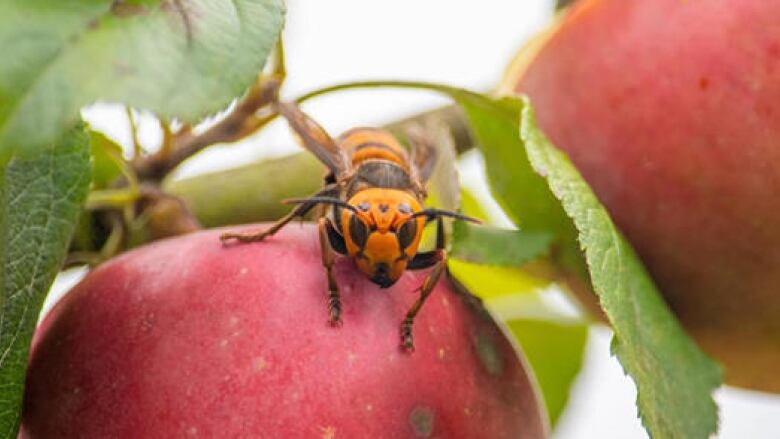B.C. to increase efforts to wipe out invasive Asian giant hornets
Hornets are considered a honeybee predator and risk to fruit crops that require pollination

British Columbia officials are increasing the number of Asian giant hornet traps set along the border with Washington state and asking for help from citizen scientists to do the same in an effort to track and destroy the invasive species.
Last year, there were six reported sightings of Asian giant hornets in the Fraser Valley, scattered between Abbotsford, Langley and White Rock, but no actual samples of the insects collected.
Even the 60 traps set by officials near the B.C.-Washington state border failed to capture a single specimen.
"Anyone can put up a trap," saidprovincial apiculturist Paul van Westendorpduring a joint media conference with Washington state officials. "We have a very simple design with a converted two litre pop bottle that serves as a good hornet trap."
Van Westendorp said traps put out by officials will be baited with either a pheromone or anorange juice and rice wine mixture that have both been successful in attracting the insect.
First Nations and a number of agencies with outdoor workers have also been put on the lookout for the insect which is sometimes called "murder hornet" in reference to itsability to kill bees.
Van Westendorp believes B.C.'s eradication program is getting results.
"I have a high level of confidence with everyone's involvement to control this invasive species," he said. "In British Columbia, we will do whatever it take to address this issue appropriately."
Watch | See the Asian giant hornet up close and hear an explanation of why they're such a problem:
Asian giant hornets have been found in the Fraser Valley, on Vancouver Island and in numerous locations in Washington state.
Last year, a nest containing 200 queens was found in a tree in aBlaine, Wash., backyard, just across the border.
Officials discovered the nest after attaching tiny transmitters to live trapped hornets. The nest was destroyed and is now being studied.
Asian giant hornets area serious honeybee predator and considered a risk to fruit and berry crops that require pollination.
They can grow up to five centimetre long, have a large orange head, mandibles and a wingspan up to seven centimetres.
Asian giant hornets were first detected in B.C. in 2017 in a Nanaimo park where a nest was found and destroyed.
Van Westendorp said last year not a single hornet was collected or sighted on Vancouver Island,and he's hoping for the same this year.
"After a two yearabsence, we will be able to declare Vancouver Island hornet free," he said.
The hornet's life cycle begins in April when queens emerge from hibernationto feed on sap and fruit and look for nesting grounds.
Van Westendorp said there was little chance of the Asian giant hornets moving east because the climate and food sources wouldn't support them.
with files from Canadian Press













_(720p).jpg)


 OFFICIAL HD MUSIC VIDEO.jpg)
.jpg)



























































































